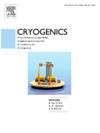Numerical simulation and loss analysis on a two-stage GM cryocooler working at liquid helium temperatures
IF 2.1
3区 工程技术
Q3 PHYSICS, APPLIED
引用次数: 0
Abstract
Two-stage Gifford-McMahon Cryocoolers (GMC) working in liquid helium temperature range are widely utilized in various fields such as low-temperature superconductors, cryogenic medical instruments, and quantum computing. However, even though they have achieved mature commercialization, their current cooling capacity and efficiency remain low for a long time in the scientific and industrial applications. An in-depth analysis of the loss distribution characteristics of GM cryocooler is crucial for guiding further performance optimization. This study establishes a comprehensive numerical simulation model for a domestically produced GM cryocooler working at liquid helium temperatures. The coupling between compressor, rotary valve, and cold head is considered. Detailed investigation on the loss characteristics in different components at different cooling temperatures are carried out. Results indicate that as the cooling temperature decreases, the proportion of the loss in the compressor and rotary valve decreases, while that of the cold head increases due to the real gas effect. At cooling temperature of 4.2 K, the loss proportions of these three components are 2689.0 W (46.2 %), 1138.9 W (19.6 %), and 1879.6 W (32.3 %), respectively. In the rotary valve, more than 70 % of its total loss is caused by friction (e.g. 793.8 W at 4.2 K). To compare the effects of different loss on the 2nd-stage cooling capacity, gross cooling capacity is used. When lower than 8 K, the of loss in the cold head is mainly due to the real gas effect (e.g. 17.53 W at 4.2 K). When higher than 8 K, the of 1st-stage irreversible heat transfer loss dominates (e.g. 15.95 W at 12 K), followed by the pressure drop loss. Therefore, to improve the performance of the cold head, best to reduce the real gas loss when lower than 8 K, and adjusting the porosity and specific heat of the fillers in the regenerator should be considered.
液氦温度下两级GM制冷机的数值模拟与损耗分析
在液氦温度范围内工作的两级Gifford-McMahon制冷机(GMC)被广泛应用于低温超导体、低温医疗仪器和量子计算等各个领域。然而,尽管它们已经实现了成熟的商业化,但它们目前的冷却能力和效率在科学和工业应用中长期处于低水平。深入分析GM制冷机的损耗分布特性对于指导进一步的性能优化至关重要。本文建立了国产GM制冷机在液氦温度下的综合数值模拟模型。考虑了压缩机、转阀和冷头之间的耦合。对不同冷却温度下不同部件的损耗特性进行了详细的研究。结果表明,随着冷却温度的降低,压缩机和旋转阀的损失比例降低,而冷头的损失比例由于真实气体效应而增加。在4.2 K的冷却温度下,这三种组分的损失率分别为2689.0 W(46.2%)、1138.9 W(19.6%)和1879.6 W(32.3%)。在旋转阀中,超过70%的总损耗是由摩擦引起的(例如,在4.2 K时793.8 W)。为比较不同损失对二级制冷量的影响,采用总制冷量Q (g)。当温度低于8 K时,冷头损失Q (g)主要是由于实际气体效应(如:4.2 K时为17.53 W)。当温度高于8 K时,第一级不可逆传热损失Q (g)占主导地位(12 K时为15.95 W),其次是压降损失。因此,要提高冷头的性能,最好在低于8 K时降低实际气体损失,并应考虑调节蓄热器内填料的孔隙率和比热。
本文章由计算机程序翻译,如有差异,请以英文原文为准。
求助全文
约1分钟内获得全文
求助全文
来源期刊

Cryogenics
物理-热力学
CiteScore
3.80
自引率
9.50%
发文量
0
审稿时长
2.1 months
期刊介绍:
Cryogenics is the world''s leading journal focusing on all aspects of cryoengineering and cryogenics. Papers published in Cryogenics cover a wide variety of subjects in low temperature engineering and research. Among the areas covered are:
- Applications of superconductivity: magnets, electronics, devices
- Superconductors and their properties
- Properties of materials: metals, alloys, composites, polymers, insulations
- New applications of cryogenic technology to processes, devices, machinery
- Refrigeration and liquefaction technology
- Thermodynamics
- Fluid properties and fluid mechanics
- Heat transfer
- Thermometry and measurement science
- Cryogenics in medicine
- Cryoelectronics
 求助内容:
求助内容: 应助结果提醒方式:
应助结果提醒方式:


